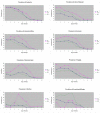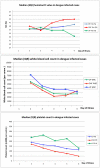Dengue infection in children in Ratchaburi, Thailand: a cohort study. II. Clinical manifestations
- PMID: 22389735
- PMCID: PMC3289597
- DOI: 10.1371/journal.pntd.0001520
Dengue infection in children in Ratchaburi, Thailand: a cohort study. II. Clinical manifestations
Abstract
Background: Dengue infection is one of the most important mosquito-borne diseases. More data regarding the disease burden and the prevalence of each clinical spectrum among symptomatic infections and the clinical manifestations are needed. This study aims to describe the incidence and clinical manifestations of symptomatic dengue infection in Thai children during 2006 through 2008.
Study design: This study is a school-based prospective open cohort study with a 9,448 person-year follow-up in children aged 3-14 years. Active surveillance for febrile illnesses was done in the studied subjects. Subjects who had febrile illness were asked to visit the study hospital for clinical and laboratory evaluation, treatment, and serological tests for dengue infection. The clinical data from medical records, diary cards, and data collection forms were collected and analyzed.
Results: Dengue infections were the causes of 12.1% of febrile illnesses attending the hospital, including undifferentiated fever (UF) (49.8%), dengue fever (DF) (39.3%) and dengue hemorrhagic fever (DHF) (10.9%). Headache, anorexia, nausea/vomiting and myalgia were common symptoms occurring in more than half of the patients. The more severe dengue spectrum (i.e., DHF) had higher temperature, higher prevalence of nausea/vomiting, abdominal pain, rash, diarrhea, petechiae, hepatomegaly and lower platelet count. DHF cases also had significantly higher prevalence of anorexia, nausea/vomiting and abdominal pain during day 3-6 and diarrhea during day 4-6 of illness. The absence of nausea/vomiting, abdominal pain, diarrhea, petechiae, hepatomegaly and positive tourniquet test may predict non-DHF.
Conclusion: Among symptomatic dengue infection, UF is most common followed by DF and DHF. Some clinical manifestations may be useful to predict the more severe disease (i.e., DHF). This study presents additional information in the clinical spectra of symptomatic dengue infection.
Conflict of interest statement
The authors have declared that no competing interests exist.
Figures
References
-
- World Health Organization. Dengue and dengue hemorrhagic fever. Fact sheet No. 117. Revised March 2009. Available at: www.who.int/mediacentre/factsheets/fs117/en/. Accessed 20August 2009. - PubMed
-
- World Health Organization. Dengue hemorrhagic fever: diagnosis, treatment, prevention and control. Geneva: WHO; 1997.
-
- Endy TP, Chunsuttiwat S, Nisalak A, Libraty DH, Green S, et al. Epidemiology of inapparent and symptomatic acute dengue virus infection: a prospective study of primary school children in Kamphaeng Phet, Thailand. Am J Epidemiol. 2002;156:40–51. - PubMed
-
- Burke DS, Nisalak A, Johnson DE, Scott RN. A prospective study of dengue infections in Bangkok. Am J Trop Med Hyg. 1988;38:172–180. - PubMed
-
- Kalayanarooj S, Vaughn DW, Nimmannitya S, Green S, Suntayakorn S, et al. Early clinical and laboratory indicators of acute dengue illness. J Infect Dis. 1997;176:313–321. - PubMed
Publication types
MeSH terms
LinkOut - more resources
Full Text Sources
Medical
Miscellaneous



